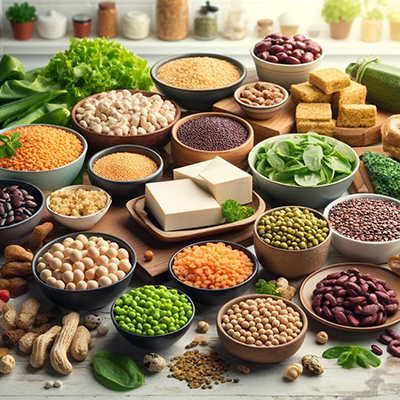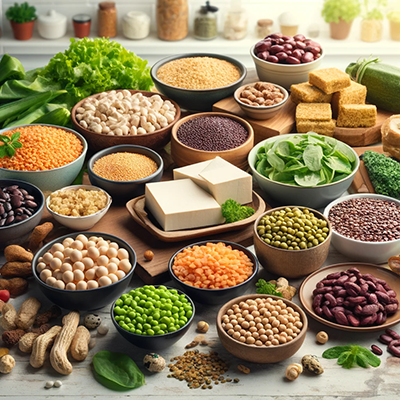Many persons often ask the question, “Where do vegetarians get their protein from?” Amazingly, plant foods provide a variety and rich option for getting protein even in larger amounts than food coming from animal origin.

All foods contain protein, though some in greater amounts than others. Protein foods are broken down to form amino acids, which are the building blocks of protein in the body. There are about 20 different amino acids in nature:
Essential: nine of them most come from the food we consume; and
Nonessential: can be made in the body if needed.
These amino acids are an essential component for our cells, muscles, tendons, tissues, hair, nails, enzymes, red blood cells and quite necessary for balancing our hormones and building our immune system. Deficiency symptoms are weakness, apathy, low immunity, edema and liver failure.
The protein found in legumes and grains combine very well since their amino acids supplement each other thus making them very nutritious, giving a complete protein. For example: Legumes are deficient in methionine but rich in lysine and Grains lack lysine but contain liberal amounts of methionine.
Eating legumes and grains either at the same meal or during the same day, gives the body the correct amounts of all amino acids needed to synthesize its own proteins. This gives the same as if one had eaten animal protein, such as meat, fish, eggs, etc. Encyclopedia of Foods and their Healing Power Vol. 1 p. 80
The following combinations when combined within a 12-hour period it provide the body the ideal proportions of amino acids to enable the body to make complete protein.
- Grains and legumes
- Grains and vegetables
- Legumes and vegetables
Encyclopedia of Foods and their Healing Power Vol. 1 p. 393
The recommended daily allowance for adult males ranges 59 – 63g and for females 44 – 50g.
It is best to get amino acids from the digested protein foods we eat rather than consuming amino acids itself as excess amino acids in our diet cannot be stored for long in the body and if they are not needed for building new proteins they are passed out into our blood stream to the liver where it is broken down then sent to the kidneys to be excreted in urine.
It is important to note that protein requires calcium for digestion. High intake of protein from animal sources, as in milk, meat, fish etc. requires greater amounts of calcium to aid with its digestion. If your diet is deficient in calcium-rich foods, for example green leafy vegetables, your body may pull calcium from your bones, leading to osteoporosis and other bone degenerating conditions; or it can cause the parathyroid to signal to the body to produce more calcium and this can be detrimental, leading to conditions such as heart palpitation and kidney stones. Other conditions such as, acid reflux or indigestion, can contribute to calcium deficiency as calcium is utilized to neutralize the acidity.
The following are some of the best plant-based sauces of protein:
Soybeans
Contains 36.5 grams per 100 edible grams
Soybean is a legume rich in protein. It can be made into a milk and a great substitute for dairy and helpful to prevent allergies, eczema, high cholesterol or gallstones
Tofu, a meat substitute made from soybeans is also rich in iron and calcium and isoflavons, found quite helpful to preventing symptoms of menopause, osteoporosis and cancer of the breast, prostate and colon.
Lentils
Contains 28.1 grams per 100 edible grams
Rich in protein, iron and fiber and useful in cases of anemia, constipation, diabetes and elevated cholesterol.
Amaranth and Quinoa
Amaranth contains 14.5 grams and Quinoa contains 8 grams per 100 edible grams
Amaranth and quinoa are ancient gluten-free grains, which unlike other grains is a complete protein as they contain all nine essential amino acids. They need to be cooked and eaten as part of a meal. When cooked they can be prepared to make milk, porridge, sauces or delicious cookies.
Baked Potato
Contains 4.29 grams per 100 edible grams
Potatoes have a composition closer to the ideal balanced diet than meat. They are remarkable for their ease of digestion. Adding green leafy vegetables, broccoli, cabbage or carrots, provides the provitamin A and calcium, which potatoes lack.
Peanut
Contains 25.8 grams per 100 edible grams
Peanuts are a highly nutritious food whose basic nutrient concentration surpasses any animal-based food, including meat. Peanuts should be combined with grains and legumes to supply all the necessary amino acids required to produce complete proteins.
Refrain from the use of peanuts if you are allergic to it.
Other great plant sauces of protein are:
- Rice
- Corn
- Hazelnut
- Chickpea
- Pistachio
- Wheat
- Buckwheat
- Spinach
- Fava bean
- Barley
Protein Bowls
- Bowl 1: Avocado, quinoa, chickpea, olives, pistachio
- Bowl 2: Lettuce, baked potatoes with onions, lentils, spinach, hazel nuts
- Bowl 3: Tomatoes, rice, fava beans, olives, peanuts
- Bowl 4: Lettuce, corn, soy beans, broccoli, almond nuts
- Bowl 5: Lettuce, buckwheat, cubed tofu, carrots, cashew nuts
Protein Recipes
Strawberry Protein Smoothie
- 1/3 cup raw cashews
- 2 cups strawberry (other fruit of choice)
- 1/2 cup organic apple juice
- 1/8 teaspoon pink Himalayan sea salt
- 1 tablespoon lemon juice
- 9 tablespoons honey
- 1 12-ounce package Mori-Nu Lite Soft Tofu
Directions:
Combine in a blender
Serve in small dessert dishes.
Chickpeas Tofu
Step 1
- Ingredients
- 2 cups chickpeas flour
- 2 cups cold water
- 2 teaspoons pink Himalayan sea salt
- 1 tablespoon onion powder
- 2 teaspoons garlic powder
Mix well, all ingredients in a bowl until smooth (may use a hand mixer)
Step 2
- 4 cups water, bring to a boil
- Add step 1 mixture to the boiling water and stir well for 2 minutes until the texture begins to get thick
Directions:
Pour hot mixture into a dish lined with wax paper
Allow to cool completely to set in place
Once set, turn over and shake out the mold chickpea tofu and cut slices
Place slices on a greased baking tray and bake in 350⁰F until golden on both sides
References: Encyclopedia of Foods and their Healing Power Vols. 1 and 2

No responses yet